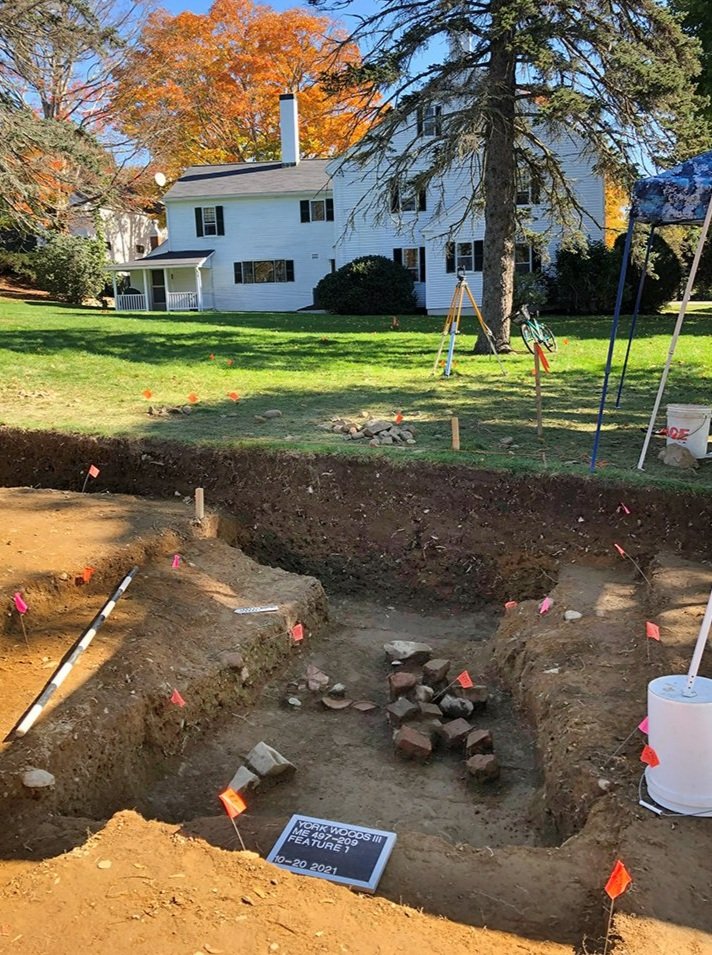The Historic Preble Homestead
By Emerson W. Baker, York resident and
Professor of History
Salem State University
Excavations of Structure 1 in October 2021 with the existing Preble home in the background (Emerson Baker photo).
Woodstone at York Village is located on the site of one of the earliest and most historic homesteads in York. Abraham Preble and Judith Tilden immigrated with their respective families from Kent, England to Scituate, Massachusetts in the 1630s. In 1639 they married, and three years later, the couple and three other Scituate families moved to York, buying land next to each other on what would be called “Scituate Men’s Row,” which is present-day York Street. At the time York was known as “Gorgeanna,” a small frontier community that had served as the capital of the fledgling Province of Maine from the time its first English settlers arrived in 1631.
Detail from the 1755 plat of the late Caleb Preble’s property (York County Registry of Probate).
The town was named in honor of Sir Ferdinando Gorges, the influential English nobleman who was the proprietor (or owner) of the colony. It was sometimes also called Agamenticus, the name the Native Wabanaki gave to the river they had lived by for thousands of years before the arrival of Europeans.
Abraham and Judith would become leading citizens of the town. Indeed, Abraham was mayor of Gorgeanna in 1652, when the residents agreed to become part of Massachusetts and the community was renamed York. The town would remain part of the Bay Colony until Maine became a state in 1820.
Extensive archaeological excavations were carried out in the fall of 2021 and winter of 2022, prior to breaking ground for Woodstone at York Village. The work focused on the section of the property next to York Street. In one of the largest and most important excavations of a colonial site in Maine, archaeologists discovered the remains of the homes lived in by Abraham and Judith Preble and several generations of their descendants.
Detail from a tracing of the ca. 1653 Province of Mayne Map, showing York and surrounding communities. (Maine State Archives).
The Preble dig, viewed from the southwest, February 2022 (Emerson Baker photo).
The IAC archaeology crew working under the tent, February 7, 2022 (Emerson Baker photo).
Archaeologists recovered thousands of artifacts – fragments of pottery and tobacco pipes, rusty nails, and other broken and discarded bits of the past. These materials, still under study by the team at Independent Archaeological Consulting, is providing many insights into life in early York.
A decorated Dutch clay tobacco pipe bowl, dating ca. 1670-1700, found on the cellar floor (in the background) of the Preble home during the 1692 raid (Emerson Baker photo).
Abraham and Judith’s son, Captain Abraham Preble Jr. and his wife Hannah Sayward Preble and their family lived on the property during King William’s War (1688-1697) a destructive frontier conflict that pitted the English against the French and their Wabanaki allies. In 1692 the Wabanaki raided York. Archaeologists found traces of Abraham and Hannah’s home, as well as the palisade – the fortified wall that helped protect their family and neighbors from an attack that resulted in the death or captivity of many York residents and the destruction of most houses on the north side of the York River. The war was a low point in the history of York and Maine. Many English and Native settlements were destroyed, with thousands of non-combatants on all sides losing their homes or lives or being forced to flee the region.
Abraham Jr. and Hannah’s son Captain Caleb Preble, and his wife Jemima Storer would be the next generation of the family to live here. In the 1730s they established the Green Dragon Tavern in their home, which is believed to be the surviving Preble home on York Street, right next to Woodstone at York Village.
The Prebles would continue to own the property for over 200 years, serving as home to six generations of the family. Some Prebles left York for new communities but continued to leave their mark. For example, Portland resident Jedidiah Preble was a brigadier general in the Massachusetts militia during the Seven Years War (1754-1763), and his son Commadore Edward Preble was the first commander of the USS Constitution. William Pitt Preble, the last member of the family to own the old homestead, was named one of the initial members of the Maine Supreme Court in 1820, and later served as Minister to the Netherlands. No wonder York historian Charles Banks referred to the Prebles as “the most distinguished family” to settle the town.
Existing eighteenth-century Preble home, site of the Green Dragon Tavern (Emerson Baker photo).
Commodore Edward Preble, after Rembrandt Peale, painted before 1807 (US Naval Academy Museum Collection).








